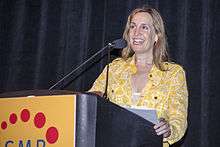Bonnie Berger
Bonnie Anne Berger is an American mathematician and computer scientist, who works as the Simons professor of mathematics and professor of electrical engineering and computer science at the Massachusetts Institute of Technology. Her research interests are in algorithms, bioinformatics[2] and computational molecular biology.[6]
Bonnie Berger | |
|---|---|
 | |
| Born | Bonnie Anne Berger |
| Alma mater | Brandeis University (SB) Massachusetts Institute of Technology (PhD) |
| Awards |
|
| Scientific career | |
| Fields | Bioinformatics[2] |
| Thesis | Using Randomness to Design Efficient Deterministic Algorithms (1990) |
| Doctoral advisor | Silvio Micali[3] |
| Doctoral students | |
| Website | people |
Education
Berger did her undergraduate studies at Brandeis University, and earned her doctorate from MIT in 1990 under the supervision of Silvio Micali.[6][3] As a student, she won the Machtey Award in 1989 for a paper on parallel algorithms that she published with fellow student John Rompel at the Symposium on Foundations of Computer Science.[7]
Career and research
After completing her PhD, Berger remained at MIT for postdoctoral research where she became a faculty member in 1992.[6] Her research in bioinformatics has been published in leading peer reviewed scientific journals including Science, the Journal of Algorithms.[2][8][9] Her former doctoral students include Serafim Batzoglou,[3] Lior Pachter,[4] Mona Singh,[5] Manolis Kellis, and Phil Bradley.
Berger has served as vice president of the International Society for Computational Biology (ISCB)[10] and chair of the steering committee for RECOMB.[11]
Awards and honours
Berger was the 1997 winner of the Margaret Oakley Dayhoff Award.[12] In 1998 she was an Invited Speaker of the International Congress of Mathematicians in Berlin (but she was unable to make a personal appearance).[13] In 1999, Berger was included in a list of 100 top innovators published by Technology Review.[14] In 2003, Berger became a Fellow of the Association for Computing Machinery (ACM),[15] and in 2012 she became an elected member of the American Academy of Arts and Sciences and a fellow the International Society for Computational Biology (ISCB).[16][17] In 2016, Berger was inducted into the college of fellows of the American Institute for Medical and Biological Engineering (AIMBE).[18] She was included in the 2019 class of fellows of the American Mathematical Society "for contributions to computational biology, bioinformatics, algorithms and for mentoring".[19] She also received the Honorary Doctorate at École Polytechnique Fédérale de Lausanne (EPFL). She serves as a Member-at-Large of the Section on Mathematics at American Association for the Advancement of Science (AAAS). She was awarded the ISCB Accomplishment by a Senior Scientist Award in 2019.[1] In 2020 she gave the AWM-SIAM Sonia Kovalevsky Lecture[20], and additionally was elected to the National Academy of Sciences.[21]
References
- Fogg, Christiana N; Shamir, Ron; Kovats, Diane E (2019). "Bonnie Berger named ISCB 2019 ISCB Accomplishments by a Senior Scientist Award recipient". Bioinformatics. 8. doi:10.1093/bioinformatics/btz389. ISSN 1367-4803. PMC 6534070. PMID 31164973.
- Bonnie Berger publications indexed by Google Scholar

- Bonnie Berger at the Mathematics Genealogy Project
- Curriculum vitae: Lior Pachter (PDF), March 2015, retrieved October 22, 2015
- Singh, Mona (1996). Learning algorithms with applications to robot navigation and protein folding (PhD thesis). Massachusetts Institute of Technology. hdl:1721.1/40579. OCLC 680493381.

- "Bonnie Berger - MIT Mathematics". math.mit.edu.
- "Bonnie Berger - Awards". doi:10.1093/bioinformatics/btz389. Cite journal requires
|journal=(help) - Roy, S.; Ernst, J.; Kharchenko, P. V.; Kheradpour, P.; Negre, N.; Eaton, M. L.; Landolin, J. M.; Bristow, C. A.; Ma, L.; Lin, M. F.; Washietl, S.; Arshinoff, B. I.; Ay, F.; et al. (2010). "Identification of Functional Elements and Regulatory Circuits by Drosophila modENCODE". Science. 330 (6012): 1787–1797. doi:10.1126/science.1198374. ISSN 0036-8075. PMC 3192495. PMID 21177974.
- Berger, Bonnie (1992). "Tight Bounds for the Maximum Acyclic Subgraph Problem". Journal of Algorithms. 25: 1–18. doi:10.1006/jagm.1997.0864.
- "Aug 18, 2014 - ISCB Announces Results of the 2014 Officer Elections". ISCB. Retrieved January 17, 2015.
- "RECOMB STEERING COMMITTEE". Retrieved March 8, 2019.
- Dayhoff Award, Biophysical Society, retrieved January 15, 2015.
- Batzoglou, Serafim; Berger, Bonnie; Kleitman, Daniel J.; Lander, Eric; Pachter, Lior (1998). "Recent developments in computational gene recognition". Doc. Math. (Bielefeld) Extra Vol. ICM Berlin, 1998, vol. I. pp. 649–658.
- "Bonnie Berger, 34", technologyreview.com, Innovators Under 35, Technology Review, 1999.
- "Bonnie Berger: ACM Fellow". awards.acm.org.
- 2012 new members, American Academy of Arts and Sciences, retrieved January 15, 2015.
- "Berger Named ISCB Fellow - MIT CSAIL". Retrieved January 17, 2015.
- "Bonnie Berger to be Inducted into Medical and Biological Engineering Elite" (PDF). AIMBE. Retrieved March 6, 2016.
- 2019 Class of the Fellows of the AMS, American Mathematical Society, retrieved November 7, 2018
- "Sonia Kovalevsky Lectures".
- "2020 NAS Election". www.nasonline.org. Retrieved June 17, 2020.